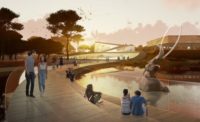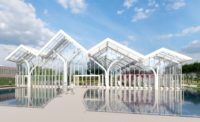Weiss/Manfredi Unveils Plan for U.S. Embassy in New Delhi

The top of a flowering tree peeks out of a sunken courtyard that brings light into the below-grade passages connecting the new office building (right) to Edward Durell Stone’s 1958 Chancery Building (left).
Rendering courtesy WEISS/MANFREDI

Weiss/Manfredi’s plan unifies the 28-acre campus.
Rendering courtesy WEISS/MANFREDI

The deep roof canopy of the new office building protects the entrance from both rain and sun, while the reflecting pond provides evaporative cooling.
Rendering courtesy WEISS/MANFREDI

The architects placed benches in shady spots throughout the lushly landscaped campus.
Rendering courtesy WEISS/MANFREDI




Architects & Firms
Designing an embassy that meets the needs of one country while respecting the context of another would be a challenge for any architect; add an existing landmark building, such as Edward Durell Stone’s 1958 Chancery Building, to the mix, and the stakes become even higher. Marion Weiss and Michael Manfredi address this challenge with their design for the forthcoming U.S. Embassy in New Delhi’s diplomatic enclave of Chanakyapuri. Their scheme for a cohesive new campus on the 28-acre site uses forms, materials, and landscape to link existing historic structures (namely, the Chancery) to contemporary ones.
Envisioned as a two-phase construction plan lasting seven to eight years, the project will break ground this spring on a new support annex, housing functional facilities such as a health unit and offices. After that, a second phase will see the construction of a new office building (NOB), to contain offices for the Ambassador and staff, as well as space for ceremonial functions. “A wandering garden path joins the two precincts to create one legible campus,” says Weiss. “The idea of this connective landscape became our thesis, to not make one garden pavilion after another, but one unified diplomatic campus.” The firm has also designed five small entry pavilions.
After receiving the commission from the State Department, Weiss/Manfredi began the master planning process in 2014. (Other ongoing U.S. embassy projects include those in Mexico City, designed by Tod Williams Billie Tsien Architects/Davis Brody Bond; Tegucigalpa, Honduras, by SHoP Architects; and Brasilia, by Studio Gang.) “Our goal was to establish a campus that was safe and secure but didn’t have the affectations of a fortress-like compound,” says Manfredi. “To do that, we drew upon traditional garden elements like walls, moats, and reflecting pools that provide a level of security but also, more importantly, provide a real connection to the great legacy of Indian architecture.”
The buildings will be clad in a series of interwoven precast-concrete fins, recalling the jali screens of vernacular Indian architecture. “They establish a pattern across the facade with links to the Edward Durell Stone building, but also to much more ancient traditions,” says Manfredi. The panels, embedded with chips of white Makrana marble, also function as a brise soleil, creating deep shadows to help keep interiors cool while framing occupants’ perspective on the surrounding landscape. “They kind of kiss and bundle up at the floor slab, and then they open up where the views are,” says Weiss.
The design responds to New Delhi’s climate, which can be very hot, very wet, and very dry over the course of a year. At the entrance to the NOB, a deep roof overhang and a reflecting pool will provide shade and evaporative cooling. A variety of Indian stone, including Golden Teak sandstone, Kota limestone, and Ambaji white marble, will be used throughout the project. “Stone is very economical to use in India,” Weiss says, “and the craftsmanship is so well done.” The original round reflecting pool in front of the Chancery will be adapted to store some 1 million gallons of water in a subsurface cistern, for landscaping and graywater reuse.
The architects’ restoration of the Chancery will “allow the building to be opened up and rejuvenated to Edward Durell Stone’s original vision,” says Weiss, by connecting it to the new office building via below-grade passageways. “There’s a series of spaces that are illuminated by sunken courtyards,” explains Manfredi, “allowing a much more integrated approach, without glomming new construction onto this beautiful historic building.”
“What we often describe as ‘honorific space,’ the State Department describes as ‘representational,’ and what’s very beautiful about that word—representation—is that these are spaces that truly represent the face of diplomacy,” says Weiss. “That term has been in our mind throughout this process.”







